Consumer Response to Cake with Apple Pomace as a Sustainable Source of Fibre
Abstract
1. Introduction
2. Materials and Methods
2.1. Apple Pomace Flour Obtention
2.2. Apple Pomace Proximate Composition
2.3. Premix Formulations and Cake Preparation
2.4. Cake Labels
2.5. Consumer Evaluation Sessions
2.5.1. Blind Test
2.5.2. Informed Test
2.6. Data Analysis
3. Results and Discussion
3.1. Apple Pomace Flour Characteristics as an Ingredient
3.2. Acceptability of Cakes in Blind and Informed Conditions
3.3. Individual Variability in Consumers’ Response to Apple Fibre-Enriched Cake
3.4. Consumer Drivers of Liking and Reasons to Purchase
4. Conclusions
Author Contributions
Funding
Acknowledgments
Conflicts of Interest
References
- USDA. Fresh Delicious Fruit: World Markets and Trade (Apples, Grapes & Pears); Foreign Agricultural Service: Washington, DC, USA, 2018; pp. 1–30.
- Rabetafika, H.N.; Bchir, B.; Blecker, C.; Richel, A. Fractionation of apple by-products as source of new ingredients: Current situation and perspectives. Trends Food Sci. Technol. 2014, 40, 99–114. [Google Scholar] [CrossRef]
- Dhillon, G.S.; Kaur, S.; Kaur Brar, S. Perspective of apple processing wastes as low-cost substrates for bioproduction of high value products: A review. Renew. Sustain. Energy Rev. 2013, 27, 789–805. [Google Scholar] [CrossRef]
- Macagnan, F.T.; Rodrigues dos Santos, L.; Sampaio, R.B.; Aline de Moura, F.; Bizzani, M.M.; Picolli da Silva, L. Biological properties of apple pomace, orange bagasse and passion fruit peel as alternative sources of dietary fibre. Bioact. Carbohydr. Diet. Fibre 2015, 6, 1–6. [Google Scholar] [CrossRef]
- Alongui, M.; Melchior, S.; Anese, M. Reducing the glycemic index of short dough biscuits by using apple pomace as a functional ingredient. LWT 2019, 100, 300–305. [Google Scholar] [CrossRef]
- American Association of Cereal Chemists—AACC. The definition of dietary fiber. Cereal Foods World 2001, 46, 112–126. [Google Scholar]
- Kruczeck, M.; Gumul, D.; Kacaniova, M.; Ivanishova, E.; Marecek, J.; Gambus, H. Industrial apple pomace by-products as a potential source of pro-health compounds in functional food. J. Microbiol. Biotechnol. Food Sci. 2017, 7, 22–26. [Google Scholar] [CrossRef]
- USDA. The Food Supply and Dietary Fiber: Its Availability and Effect on Health, Nutrition Insight 36; USDA Center for Nutrition Policy and Promotion: Washington, DC, USA, 2007.
- Masoodi, F.; Sharma, B.; Chauhan, G. Use of apple pomace as a source of dietary fiber in cakes. Plant Foods Hum. Nutr. 2002, 57, 121–128. [Google Scholar] [CrossRef]
- Rupasinghe, H.P.V.; Wang, L.; Huber, G.M.; Pitts, N.L. Effect of baking on dietary fibre and phenolics of muffins incorporated with apple skin powder. Food Chem. 2008, 107, 1217–1224. [Google Scholar] [CrossRef]
- Ares, G.; Deliza, R. Studying the Influence of Package Shape and Colour on Consumer Expectations of Milk Desserts Using Word Association and Conjoint Analysis. Food Qual. Pref. 2010, 2, 930–937. [Google Scholar] [CrossRef]
- Carrillo, E.; Varela, P.; Fiszman, S. Effects of food package information and sensory characteristics on the perception of healthiness and the acceptability of enriched biscuits. Food Res. Int. 2012, 48, 209–216. [Google Scholar] [CrossRef]
- Chrea, C.; Melo, L.; Evans, G.; Forde, C.; Delahunty, C.; Cox, D.N. An investigation using three approaches to understand the influence of extrinsic product cues on consumer behavior: An example of Australian wines. J. Sens. Stud. 2011, 26, 13–24. [Google Scholar] [CrossRef]
- Deliza, R.; MacFie, H. The Generation of Sensory Expectation by External Cues and Its Effect on Sensory Perception and Hedonic Ratings: A Review. J. Sens. Stud. 1996, 11, 103–128. [Google Scholar] [CrossRef]
- Reis, F.; Alcaire, F.; Deliza, R.; Ares, G. The role of information on consumer sensory, hedonic and wellbeing perception of sugar-reduced products: Case study with orange/pomegranate juice. Food Qual. Pref. 2017, 62, 227–236. [Google Scholar] [CrossRef]
- Grunert, K.G. Current issues in the understanding of consumer food choice. Trends Food Sci. Technol. 2002, 13, 275–285. [Google Scholar] [CrossRef]
- Deliza, R.; MacFie, H.; Hedderley, A. Consumer attitude towards information on non conventional technology. Trends Food Sci. Technol. 2003, 14, 43–49. [Google Scholar] [CrossRef]
- Costell, E.; Tárrega, A.; Bayarri, S. Food Acceptance: The Role of Consumer Perception and Attitudes. Chem. Percept. 2010, 3, 42–50. [Google Scholar] [CrossRef]
- Mueller, S.; Szolnoki, G. The relative influence of packaging, labelling, branding and sensory attributes on liking and purchase intent: Consumers differ in their responsiveness. Food Qual. Pref. 2010, 21, 774–783. [Google Scholar] [CrossRef]
- Ginon, E.; Lohéac, Y.; Martin, C.; Combris, P.; Issanchou, S. Effect of fibre information on consumer willingness to pay for French baguettes. Food Qual. Pref. 2009, 20, 343–352. [Google Scholar] [CrossRef]
- Gebsky, J.; Jesewska-Zychowicz, M.; Szlanchciuk, J.; Kosicka-Gebska, M. Impact of nutritional claims on consumer preferences for bread with varied fibre and salt content. Food Qual. Pref. 2019, 76, 91–99. [Google Scholar] [CrossRef]
- Baixauli, R.; Salvador, A.; Hough, G.; Fiszman, S.M. How information about fibre (traditional and resistant starch) influences consumer acceptance of muffins. Food Qual. and Pref. 2008, 19, 628–635. [Google Scholar] [CrossRef]
- Antonic, B.; Jancikova, S.; Dordevic, D.; Tremlova, B. Apple pomace as food fortification ingredient: A systematic review and meta-analysis. J. Food Sci. 2020, 85, 2977–2985. [Google Scholar] [CrossRef]
- AOAC. Official Methods of Analysis of AOAC International, 19th ed.; AOAC International: Gaithersburg, MD, USA, 2012. [Google Scholar]
- ISO-6492-1999. International Organization for Standardization, Animal Feeding Stuffs—Determination of Fat Content; ISO: Geneva, Switzerland, 1999. [Google Scholar]
- ISO-5984-2002. International Organization for Standardization, Animal Feeding Stuffs—Determination of Crude Ash; ISO: Geneva, Switzerland, 2002. [Google Scholar]
- Reglamento Técnico MERCOSUR sobre Información Nutricional Complementaria (Declaraciones de Propiedades Nutricionales). MERCOSUR/GMC/RES. N°01/12. Available online: http://www.puntofocal.gov.ar/notific_otros_miembros/pry33a1_t.pdf (accessed on 1 August 2019).
- Trías, J.; Curutchet, A.; Arcia Cabrera, P.; Cozzano, S. Revalorización del descarte originado por la producción de jugo de manzana como ingrediente funcional en la formulación de premezclas para horneados. INNOTEC 2021, 21, 52–67. [Google Scholar] [CrossRef]
- Roininen, K.; Lähteenmäki, L.; Tuorila, H. Quantification of Consumer Attitudes to Health and Hedonic Characteristics of Foods. Appetite 1999, 33, 71–88. [Google Scholar] [CrossRef]
- Villegas, B.; Carbonell, I.; Costell, E. Effects of product information and consumer attitudes on responses to milk and soybean vanilla beverages. J. Sci. Food Agric. 2008, 88, 2426–2434. [Google Scholar] [CrossRef]
- Levy, K.J. Large-sample pair-wise comparisons involving correlations, proportions, or variances. Psychol. Bull. 1975, 82, 174–176. [Google Scholar] [CrossRef]
- Azari, M.; Shojaee-Aliabadi, S.; Hosseini, H.; Mirmoghtadaie, L.; Marzieh Hosseini, S. Optimization of physical properties of new gluten-free cake based on apple pomace powder using starch and xanthan gum. Food Sci. Technol. Int. 2020, 26, 603–613. [Google Scholar] [CrossRef]
- Biguzzi, C.; Schlich, P.; Lange, C. The impact of sugar and fat reduction on perception and liking of biscuits. Food Qual. Pref. 2014, 35, 41–47. [Google Scholar] [CrossRef]
- Laureati, M.; Conte, A.; Padalino, L.; Alessandro del Nobile, M.; Pagliarini, E. Effect of fibre information on consumer’s expectation and liking of wheat bran enriched pasta. J. Sens. Stud. 2016, 31, 348–359. [Google Scholar] [CrossRef]
- Mialon, V.S.; Clark, M.R.; Leppard, P.I.; Cox, D.N. The effect of dietary fibre information on consumer responses to breads and “English” muffins: A cross-cultural study. Food Qual. Prefer. 2002, 13, 1–12. [Google Scholar] [CrossRef]
- Saba, A.; Vassallo, M.; Shepherd, R.; Lampila, P.; Arvola, A.; Dean, M.; Winkelmann, M.; Claupein, E.; Lähteenmäki, L. Country-wise differences in perception of health-related messages in cereal-based food products. Food Qual. Prefer 2010, 21, 385–393. [Google Scholar] [CrossRef]
- Tarrega, A.; Quiles, A.; Morell, P.; Fiszman, S.; Hernando, I. Importance of consumer perceptions in fibre/enriched food products. A case study with sponge cakes. Food Function 2016, 8, 574–583. [Google Scholar] [CrossRef] [PubMed]
- Koskinen, S.; Kälviäinen, N.; Tuorila, H. Perception of chemosensory stimuli and related responses to flavored yogurts in the young and elderly. Food Qual. Prefer 2003, 14, 623–635. [Google Scholar] [CrossRef]
- Pohjanheimo, T.; Paasovaara, R.; Luomala, H.; Sandell, M. Food choice motives and bread liking of consumers embracing hedonistic and traditional values. Appetite 2010, 54, 170–180. [Google Scholar] [CrossRef]
- Vorage, L.; Wiseman, N.; Graca, J.; Harris, N. The Association of Demographic characteristics and food choice motives with the consumption of functional foods in emerging adults. Nutrients 2020, 12, 2582. [Google Scholar] [CrossRef] [PubMed]
- Nelson, M.; Story, M.; Larson, N. Emerging adulthood and college-aged youth: An overlooked age for weight-related behavior change. Obesity 2008, 16, 2205–2211. [Google Scholar] [CrossRef]
- Kaczorowska, J.; Rejman, K.; Halicka, E.; Szczebylo, A.; Gorska-Warsewicz, H. Impact of food sustainability labels on the perceived product value and price expectations of urban consumers. Sustainability 2019, 11, 7240. [Google Scholar] [CrossRef]
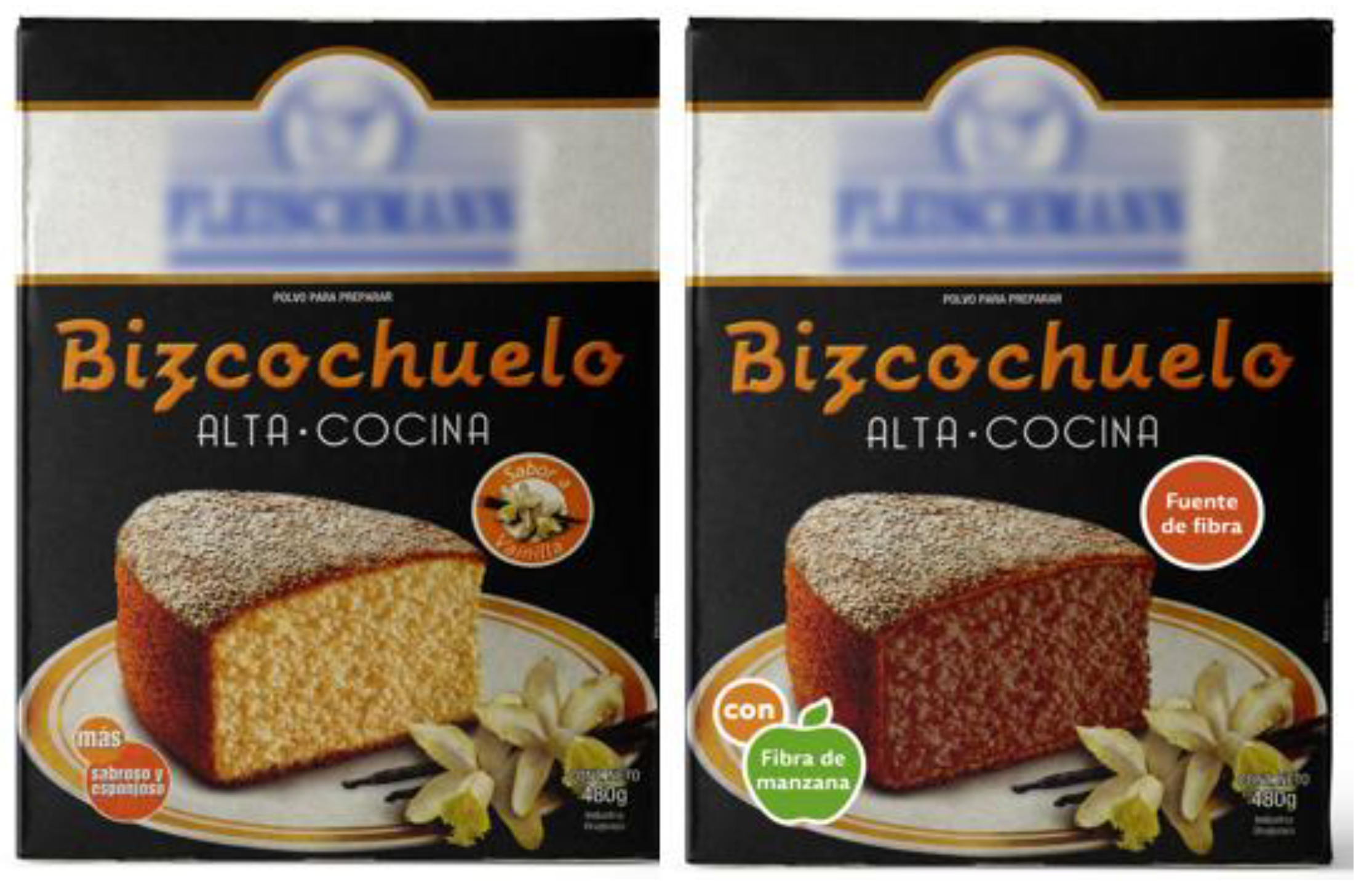
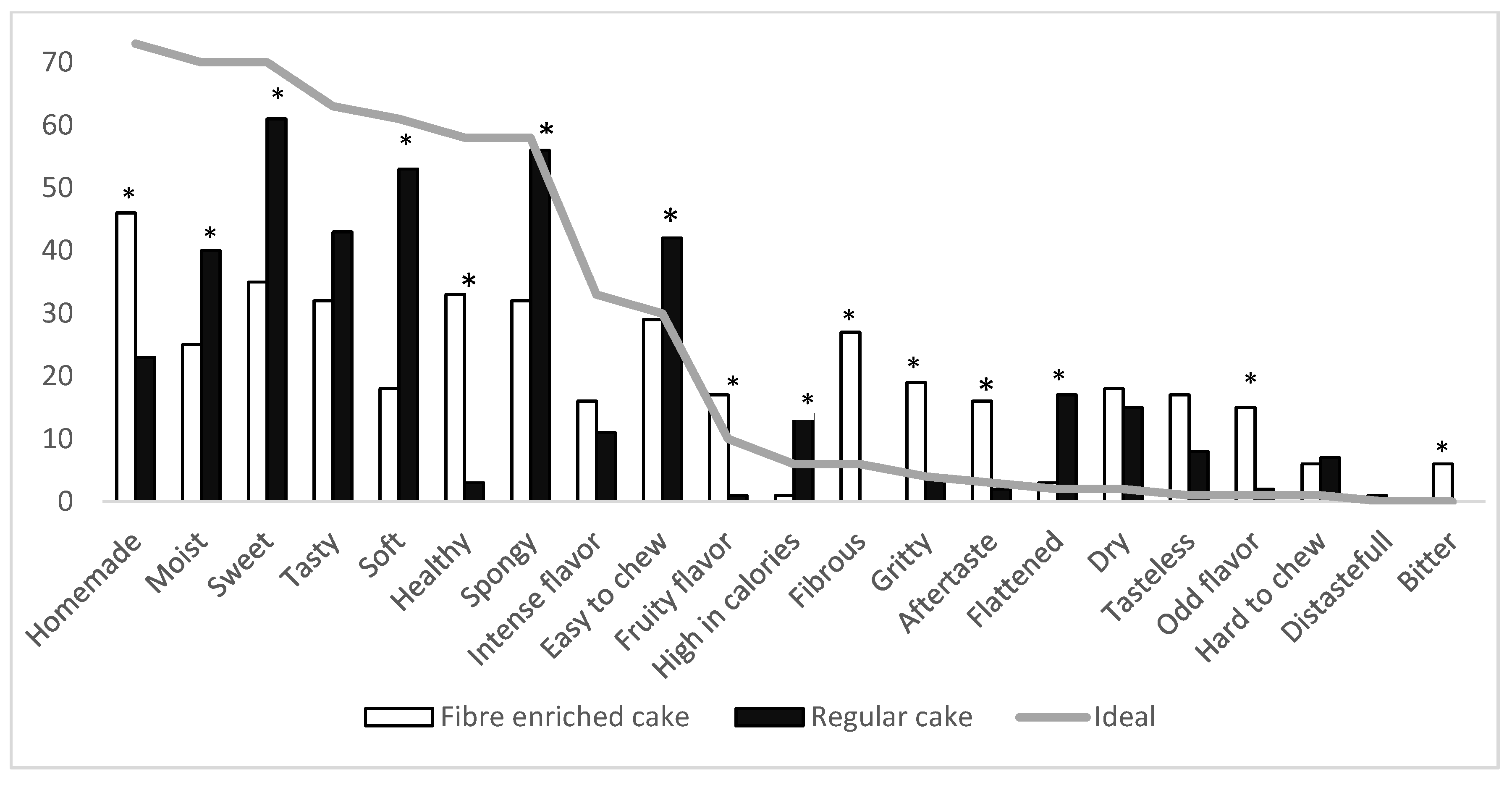
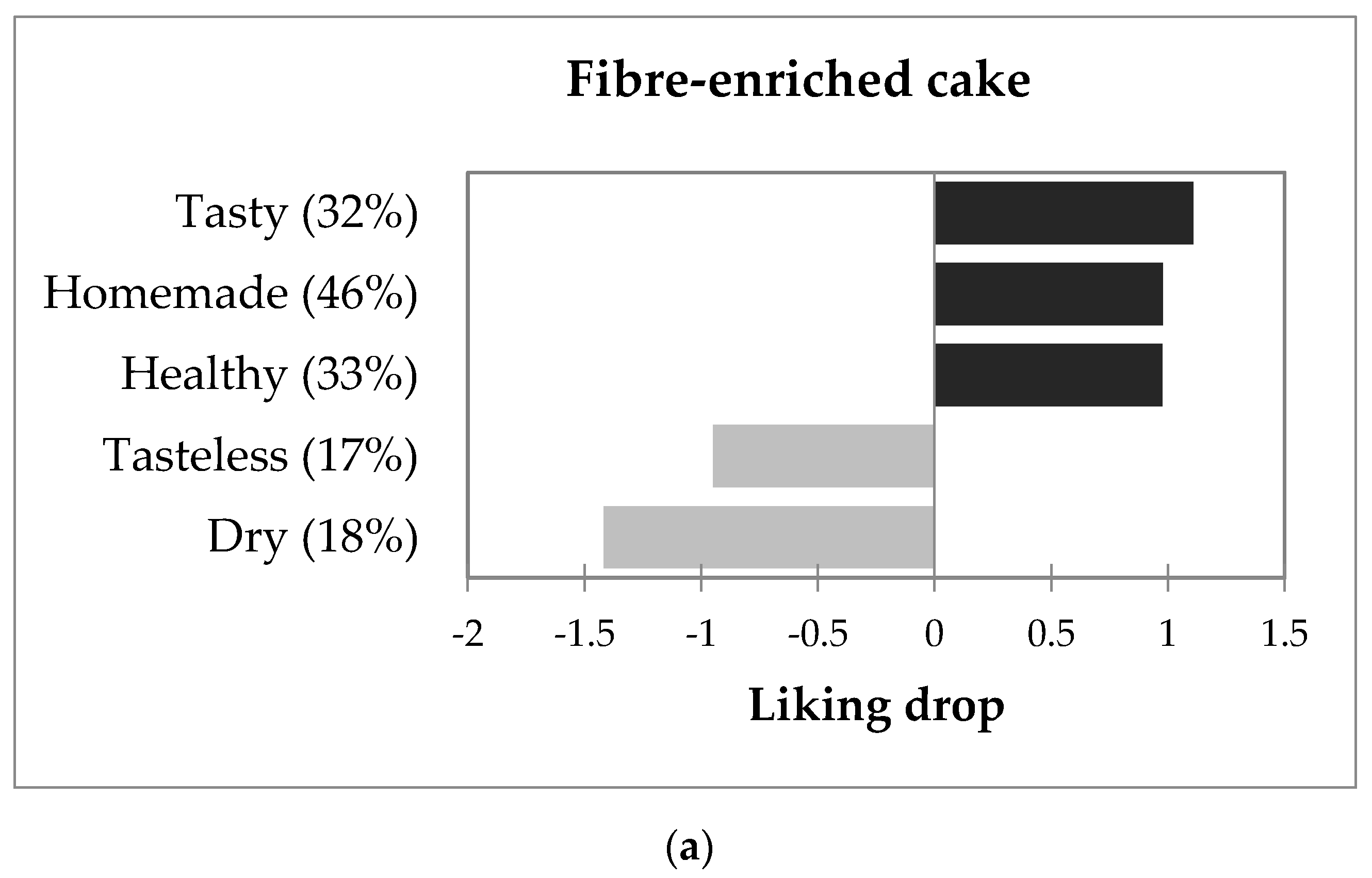
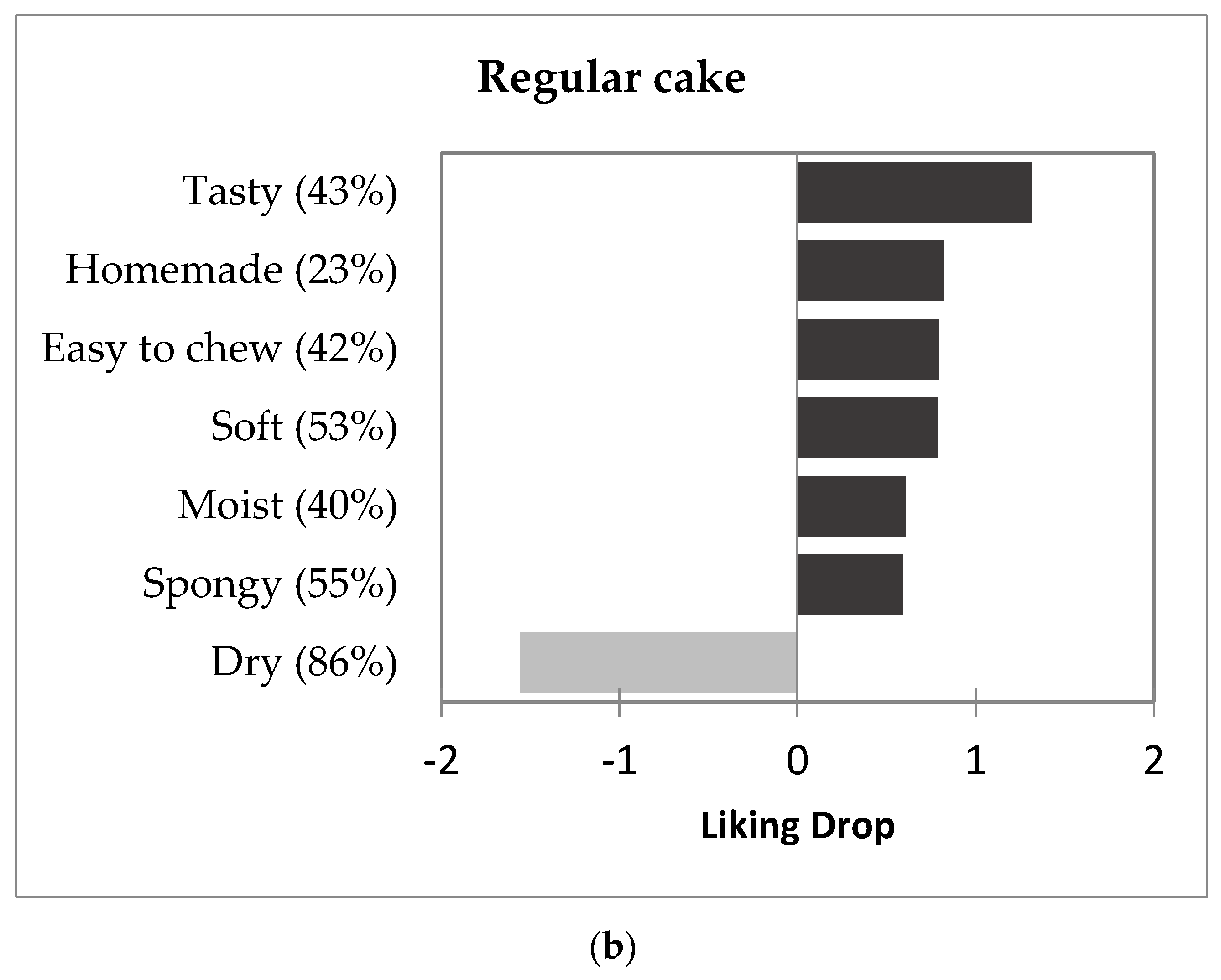
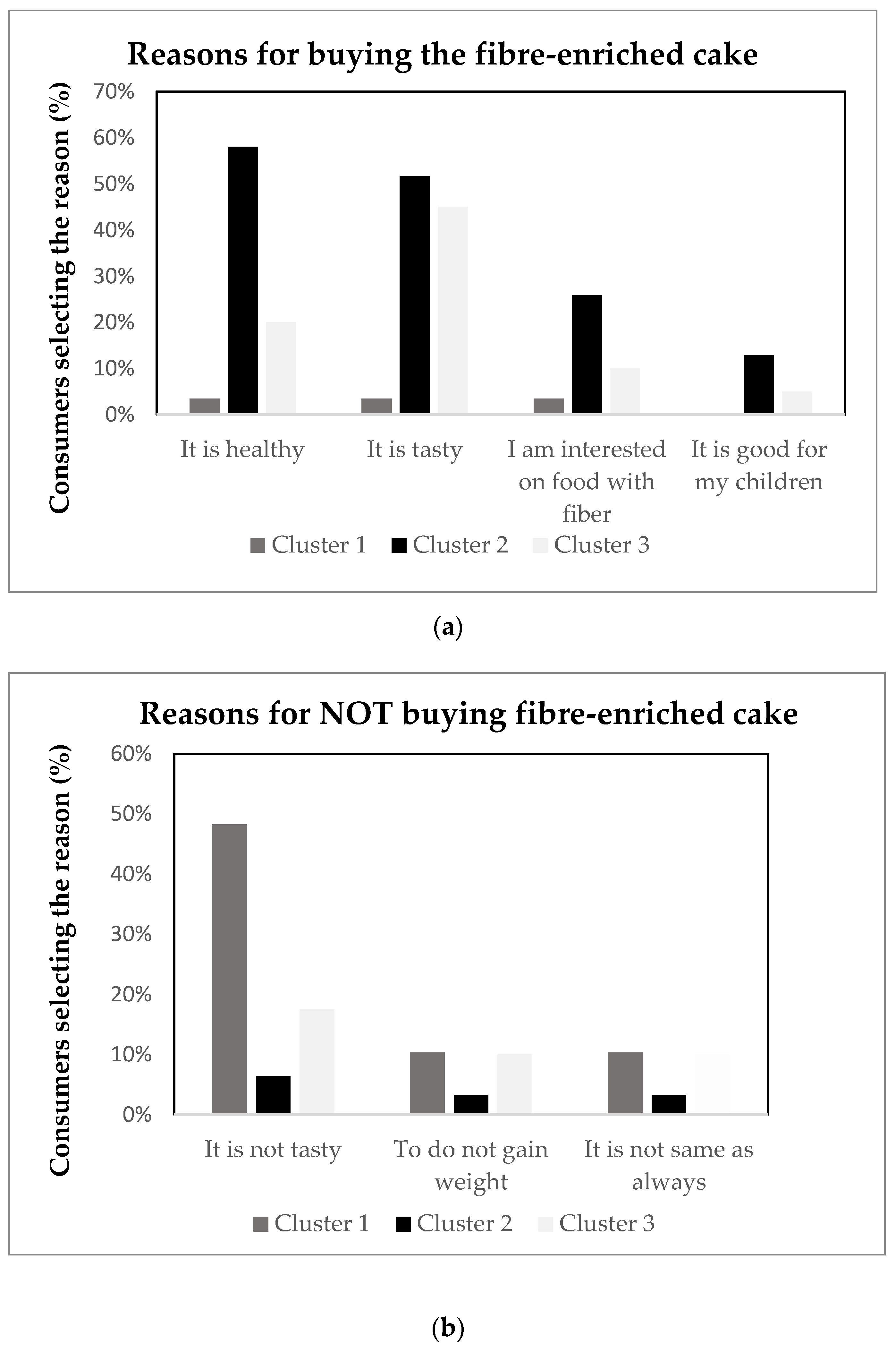
| Ingredients | Amount in Premix (%) | Amount in the Cake (%) |
|---|---|---|
| Wheat flour | 35.67 | 20.55 |
| Apple pomace flour | 23.18 | 13.36 |
| Sugar | 31.21 | 17.98 |
| Baking powder | 4.46 | 2.57 |
| Skim milk powder | 3.57 | 2.05 |
| Vanilla flavor | 1.92 | 1.10 |
| Vegetable oil | - | 7.71 |
| Eggs | - | 12.84 |
| Water | - | 21.83 |
| Ingredients | Fibre Enriched Cake | Regular Cake |
|---|---|---|
| Energy | 275 kcal = 1149 kJ | 332 kcal = 1388 kJ |
| Carbohydrate | 43 g | 52 g |
| Protein | 4.8 g | 11 g |
| Total fat | 9.5 | 8.7 g |
| from which saturated | 1.1 g | 3.2 g |
| Dietary fibre | 6.3 g | 1.0 g |
| Sodium | 280 mg | 448 g |
| Why would you buy it? |
| 1. Because it is healthy |
| 2. Because it is tasty |
| 3. Because it is the one I always buy |
| 4. Because I don’t need fibre in my diet |
| 5. Because it is low in calories |
| 6. To avoid weight gain |
| 7. Because it is good for my kids |
| 8. Because I want to include fibre in my diet |
| 9. Because my kids would like it. |
| Why wouldn’t you buy it? |
| 1. Because it is not healthy |
| 2. Because it is distasteful |
| 3. Because it is not the one I always buy |
| 4. Because I need fibre in my diet |
| 5. Because it is calorific |
| 6. To prevent weight gain |
| 7. Because it is bad for my kids |
| 8. Because I don’t want to include fibre in my diet |
| 9. Because my kids wouldn’t like it. |
| Proteins | 3.04 ± 0.18 |
| Lipids | 3.08 ± 0.08 |
| Ash | 2.07 ± 0.10 |
| Dietary fibre | 38.48 ± 0.20 |
| Carbohydrates | 47.47 1 |
| Product | Blind Condition | Informed Condition | Intention to Purchase |
|---|---|---|---|
| Fibre-enriched cake | 5.34 ± 1.80 a,A | 6.55 ± 1.58 a,B | 3.42 ± 1.02 a |
| Regular cake | 6.70 ± 1.74 b,A | 7.06 ± 1.50 b,A | 3.69 ± 0.99 b |
| Product | Cluster 1 (29%) | Cluster 2 (31%) | Cluster 3 (40%) |
|---|---|---|---|
| Apple fibre cake | 4.5 a | 7.4 a | 7.3 a |
| Regular cake | 6.5 b | 5.9 b | 8.3 b |
| Age (>35 years) * | 35 A | 58 B | 39 A,B |
Publisher’s Note: MDPI stays neutral with regard to jurisdictional claims in published maps and institutional affiliations. |
© 2021 by the authors. Licensee MDPI, Basel, Switzerland. This article is an open access article distributed under the terms and conditions of the Creative Commons Attribution (CC BY) license (http://creativecommons.org/licenses/by/4.0/).
Share and Cite
Curutchet, A.; Trias, J.; Tárrega, A.; Arcia, P. Consumer Response to Cake with Apple Pomace as a Sustainable Source of Fibre. Foods 2021, 10, 499. https://doi.org/10.3390/foods10030499
Curutchet A, Trias J, Tárrega A, Arcia P. Consumer Response to Cake with Apple Pomace as a Sustainable Source of Fibre. Foods. 2021; 10(3):499. https://doi.org/10.3390/foods10030499
Chicago/Turabian StyleCurutchet, Ana, Julieta Trias, Amparo Tárrega, and Patricia Arcia. 2021. "Consumer Response to Cake with Apple Pomace as a Sustainable Source of Fibre" Foods 10, no. 3: 499. https://doi.org/10.3390/foods10030499
APA StyleCurutchet, A., Trias, J., Tárrega, A., & Arcia, P. (2021). Consumer Response to Cake with Apple Pomace as a Sustainable Source of Fibre. Foods, 10(3), 499. https://doi.org/10.3390/foods10030499







